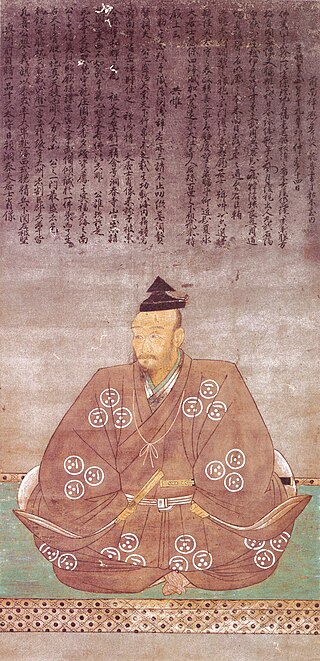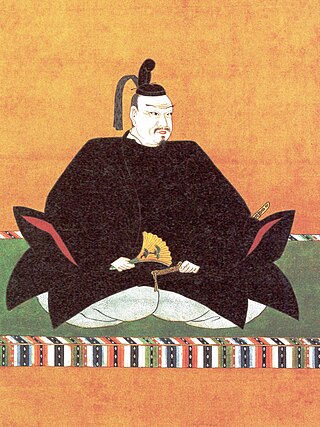
Mōri Motonari was a prominent daimyō in the western Chūgoku region of Japan during the Sengoku period of the 16th century. The Mōri clan claimed descent from Ōe no Hiromoto (大江広元), an adviser to Minamoto no Yoritomo. Motonari was called the "Beggar Prince". He was known as a great strategist who began as a small local warlord (jizamurai) of Aki Province and extended his clan's power to nearly all of the Chūgoku region through war, marriage, adoption and assassination.

The Amago clan, descended from the Emperor Uda (868–897) by the Kyogoku clan, descending from the Sasaki clan.

Amago Haruhisa was a daimyō warlord in the Izumo Province, Chūgoku region of western Japan. He was the second son of Amago Masahisa. Initially named Akihisa (詮久), he changed his name to Haruhisa in 1541 after Ashikaga Yoshiharu offered to let him use a kanji character from his name.

Amago Katsuhisa was a remnant of the Amago clan, a powerful feudal clan in the Chūgoku region of Japan, backed up by Yamanaka Yukimori, a vassal of the clan.
Amago Kunihisa was a Japanese warlord during the Sengoku period of western Honshu. He was a son of Amago Tsunehisa.

Amago Tsunehisa was a powerful warlord who gained the hegemony in Chūgoku region, Japan starting as a vassal of the Rokkaku clan. He ruled the domains of Inaba, Hōki, Izumo, Iwami, Oki, Harima, Mimasaka, Bizen, Bitchū, Bingo, and Aki.

The Mōri clan was a Japanese samurai clan descended from Ōe no Hiromoto. Ōe no Hiromoto was descended from the Fujiwara clan. The family's most illustrious member, Mōri Motonari, greatly expanded the clan's power in Aki Province. During the Edo period his descendants became daimyō of the Chōshū Domain under the Tokugawa shogunate. After the Meiji Restoration with the abolition of the han system and daimyō, the Mōri clan became part of the new nobility.

Mōri Terumoto was a Japanese daimyō. The son of Mōri Takamoto, and grandson and successor of the great warlord Mōri Motonari, he fought against Oda Nobunaga but was eventually overcome. He participated in Toyotomi Hideyoshi's Korean Campaign (1592) and built Hiroshima Castle, thus essentially founding Hiroshima.

Kikkawa Hiroie was a Japanese daimyō of the Azuchi–Momoyama period through early Edo period. Hiroie's father was Kikkawa Motoharu and his mother was a daughter of Kumagai Nobunao.

Ōuchi Yoshitaka was the daimyō of Suō Province and the head of the Ōuchi clan, succeeding Ōuchi Yoshioki.

Shimazu Yoshihisa was a powerful daimyō and the 16th Chief of Shimazu clan of Satsuma Province, the eldest son of Shimazu Takahisa. He was renowned as a great general, who managed to subjugate Kyushu through the deft maneuvering of his three brothers. Eventually, in 1585, Yoshihisa seceded control of the entire Kyushu region.

Sue Harukata was a samurai who served as a senior retainer of the Ōuchi clan in the Sengoku period in Japan. He was the second son of Sue Okifusa, a senior retainer of the Ōuchi clan. His childhood name was Goro, and he previously had the name Takafusa.
The Siege of Kōzuki Castle occurred in 1578, when the army of Mōri Terumoto attacked and captured the castle of Kōzuki in Harima Province. Kōzuki had been taken by Toyotomi Hideyoshi the previous year and entrusted to Amago Katsuhisa. When it fell to the Mōri, Amago committed hara-kiri. Amago's loyal and heroic general Yamanaka Yukimori was captured and executed.

Kikkawa Motoharu was the second son of Mōri Motonari, and featured prominently in all the wars of the Mōri clan. He became an active commander of the Mōri army and he with his brother Kobayakawa Takakage became known as the “Mōri Ryōsen", or “Mōri's Two Rivers" (毛利両川).

The Siege of Gassantoda Castle was a battle during the Sengoku period of Japan.
Siege of Koriyama took place from 5 October 1540 until 8 February 1541 in Yoshida, Aki Province, Japan during the Sengoku period. Amago Haruhisa, with 30,000 men, attacked Kōriyama Castle, which belonged to Mōri Motonari and was defended by 8,000 men. When the Ōuchi clan sent an army under the command of Sue Harukata to relieve the siege, the Amago were forced to leave.

Gassantoda Castle was a Sengoku period yamajiro-style Japanese castle located in Izumo Province, in what is now part of the city of Yasugi, Shimane Prefecture in the San'in region of far western Japan. Its ruins have been protected by the central government as a National Historic Site since 1934. Gassantoda Castle was built using the whole of Gassan's ridges and valleys, and is regarded as one of the five largest and most important medieval mountain castles along with Kasugayama Castle (Niigata), Nanao Castle (Ishikawa), Odani Castle and Kannonji Castle (Shiga).
Hayashi Narinaga was a samurai during the Sengoku period, retainer of the Mōri clan and was a ji-samurai (koku-jin-ryōshū) of southern Bingo Province. He held many positions including karō serving Mōri Motonari and his father Mōri Hiromoto in diplomatic missions with Toyotomi Hideyoshi. Narinaga was a bugyō under Mōri Terumoto. From Hideyoshi he received the rank of Hizen-no-kami (肥前守). He served as diplomat between the Mōri and Hideyoshi. Later he was bestowed the 5th court rank, junior grade Ju go-i-no-ge (従五位). The character "nari, 就" came from his lord Mōri Motonari and "naga, 長" from his father Kikuchi Takenaga. Narinaga was one of the few to live through all the Sengoku period.

Tajihi-Sarugake Castle was a Japanese castle located in Akitakata, Hiroshima Prefecture. Its ruins have been protected by the central government as a National Historic Site together with Yoshida-Kōriyama Castle since 1940.













